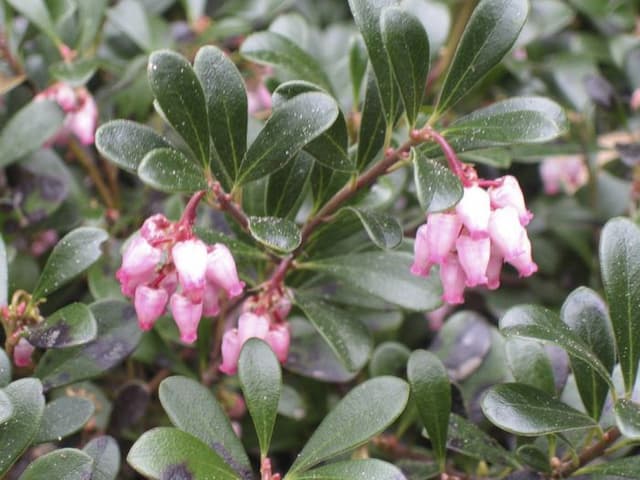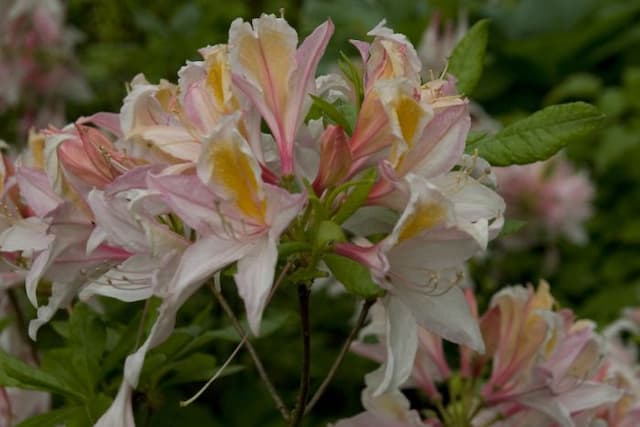Taiwan pieris Pieris formosa

ABOUT
P. formosa is a large, upright, evergreen shrub with glossy, dark green leaves up to 10cm long. In spring, the young foliage is bronze, and small, white, waxy, flowers are produced in large sprays at the ends of the branches
About this plant
 Names
NamesSynonyms
Formosa Pieris, Himalayan Pieris
Common names
Pieris formosa var. forrestii, Pieris forrestii
 Characteristics
CharacteristicsLife cycle
Perennials
Foliage type
Evergreen
Color of leaves
Varies
Flower color
White
Height
6-15 feet (1.8-4.6 meters)
Spread
6-15 feet (1.8-4.6 meters)
Plant type
Shrub
Hardiness zones
5-8
Native area
Asia
Benefits
 General Benefits
General Benefits- Ornamental Value: Pieris formosa, commonly known as the Himalayan Pieris, is valued for its decorative evergreen foliage and clusters of attractive bell-shaped flowers.
- Low Maintenance: Once established, this plant requires minimal care, adapting well to a range of soil conditions and needing only occasional pruning to maintain shape and encourage blooming.
- Shade Tolerance: The Himalayan Pieris can thrive in partial shade, making it a suitable choice for understory planting in woodland gardens or shaded areas.
- Attracts Pollinators: The flowers of Pieris formosa are attractive to bees and other pollinating insects, enhancing biodiversity in the garden setting.
- Year-Round Interest: With its evergreen leaves, showy flowers in spring, and sometimes reddish or bronzed new growth, the Himalayan Pieris offers visual interest throughout the year.
- Deer Resistance: The Himalayan Pieris is less palatable to deer than many other garden plants, reducing the risk of damage in areas with high deer populations.
 Medical Properties
Medical PropertiesThis plant is not used for medical purposes.
 Air-purifying Qualities
Air-purifying QualitiesThis plant is not specifically known for air purifying qualities.
 Other Uses
Other Uses- Pieris formosa, commonly known as the Himalayan Pieris, can be used as a source of biomass in the production of bioenergy, as its woody parts can be processed into fuels such as pellets or chips.
- The wood of Himalayan Pieris is sometimes used in fine woodworking or for the production of small wooden objects, as it can give an ornamental touch due to its potential patterns and coloration.
- Extracts from the leaves of Himalayan Pieris are explored for use in organic pesticides due to their natural bioactive compounds that may deter pests.
- The tannins present in Himalayan Pieris could be harvested for the tanning industry, where they might be used in processing leather.
- Himalayan Pieris may serve as a natural dye source, with various parts of the plant potentially providing hues for textiles or crafts.
- The acid-loving properties of Himalayan Pieris make it a suitable candidate for use in companion planting, to acidify the soil for neighboring plants that require similar conditions.
- The dense growth habit of Himalayan Pieris can offer habitats and shelter for small wildlife and beneficial insects within a garden ecosystem.
- During the winter, the Himalayan Pieris provides visual interest in gardens due to its evergreen foliage and sometimes colorful new growth.
- The flowers of Himalayan Pieris can be used in floristry as they provide an exotic aesthetic to bouquets and floral arrangements.
- Himalayan Pieris is sometimes included in educational programs about botany and horticulture, serving as a practical example of an acidophilic plant.
Interesting Facts
 Feng Shui
Feng ShuiThe plant_name is not used in Feng Shui practice.
 Plant Symbolism
Plant Symbolism- Renewal - The Pieris formosa, commonly known as Forest Flame, often symbolizes renewal due to its ability to flower each spring without fail, heralding the end of winter and the arrival of new growth.
- Beauty and Elegance - With its cascading white or pink flowers and vibrant red to copper new leaves, the Forest Flame is often associated with natural beauty and elegance.
- Protection - The toxicity of the plant makes it deer-resistant and can symbolize protection; as such, planting Forest Flame might be seen as a way to guard a space with its natural resilience.
 Water
WaterFor Himalayan Pieris, regular watering is essential, particularly during its first growing season to establish a deep, extensive root system. The soil should be kept consistently moist but not waterlogged. Water the plant deeply once a week, providing about a gallon of water per session. Adjust the watering frequency depending on weather conditions; during periods of drought or extreme heat, additional water may be needed. Ensure adequate drainage to prevent root rot, and reduce watering in the winter when the plant is dormant.
 Light
LightHimalayan Pieris thrives best in partial shade to full sun conditions. It should be positioned in a spot where it can receive morning sunlight and afternoon shade, which helps protect it from the scorching heat. Dappled sunlight throughout the day is ideal, as harsh afternoon sun can lead to foliage burn, especially in warmer climates.
 Temperature
TemperatureHimalayan Pieris is hardy in temperatures as low as 0 to 10 degrees Fahrenheit and can tolerate a maximum temperature around 90 degrees Fahrenheit. However, the ideal temperature range for this plant is between 60 and 75 degrees Fahrenheit, as it prefers cooler conditions. Protect the plant from freezing temperatures and hot summer sun by choosing a suitable location that moderates temperature extremes.
 Pruning
PruningPrune Himalayan Pieris to maintain shape and encourage bushier growth, typically after it has finished flowering in late spring. Removing spent flower clusters can also promote next year's bloom. Pruning is necessary for removing any dead or damaged wood, as well as to rejuvenate older plants. Annual thinning may be needed to ensure adequate light and air penetration throughout the plant for overall health. Avoid heavy pruning; instead, selectively cut back branches to maintain the natural shape of the shrub.
 Cleaning
CleaningAs needed
 Soil
SoilHimalayan Andromeda, or Pieris formosa, thrives in moist but well-draining soil with a high content of organic matter. A mixture of peat, pine bark, and perlite makes an excellent soil base. The soil pH should be acidic, ideally between 4.5 and 6.0, to accommodate this plant's preferences.
 Repotting
RepottingHimalayan Andromeda should be repotted every 2 to 3 years, or when it outgrows its current pot. Spring is the ideal time for repotting this plant to allow for recovery during the growing season.
 Humidity & Misting
Humidity & MistingHimalayan Andromeda benefits from moderate to high humidity levels. Aim to maintain about 50-60% relative humidity around the plant for optimal growth conditions.
 Suitable locations
Suitable locationsIndoor
Place Himalayan Andromeda in bright, indirect light indoors; water when topsoil feels dry.
Outdoor
Plant Himalayan Andromeda in part shade, acid soil, shelter from harsh winds.
Hardiness zone
7-9 USDA
 Life cycle
Life cycleThe life of the Himalayan Pieris, Pieris formosa, begins as a dormant seed which germinates in moist, well-drained soil, usually under partial shade. Upon sprouting, the seedling phase involves the development of primary leaves and root systems. As it matures into a vegetative state, it forms a shrub with evergreen leaves and starts to develop buds. The flowering stage arrives normally in early spring, yielding white, bell-shaped flowers clustered in panicles that are attractive to pollinators. After pollination, the plant produces capsule-like fruits that release seeds, continuing its reproductive cycle. Meanwhile, the Himalayan Pieris undergoes periodic growth each season, adding to its woody stems and foliage while older parts of the plant may die back gradually.
 Propogation
PropogationPropogation time
Spring
The most popular method for propagating the Lily-of-the-Valley Shrub, or Pieris formosa, is through semi-ripe cuttings. This typically takes place in late summer. To properly propagate, take cuttings of about 4 to 6 inches (10 to 15 cm) in length from the current year’s growth, ensuring each cutting has a few leaves. The cut end of the cutting should be dipped in rooting hormone to encourage root development before being inserted into a pot filled with a well-draining potting mix. The pot should then be covered with plastic to retain humidity and placed in a warm spot with indirect sunlight. Roots usually develop within several weeks, at which point the new plant can be gradually acclimated to normal conditions and eventually transplanted.









